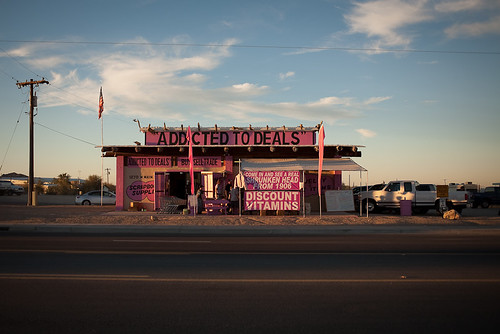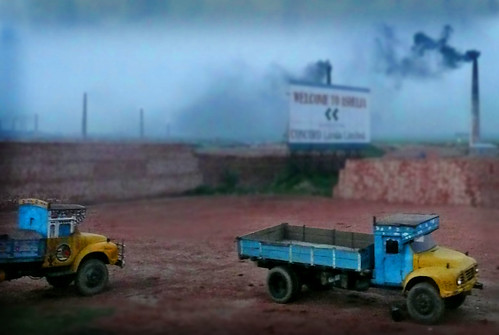I listened with great interest to a recent episode of Speaking of Faith, devoted to changing values in the economic downturn, and titled Repossessing Virtue. Instead of drawing conclusions about how nationwide values have changed, it offered thoughts about how individual values can change. I think there’s a lot to be said for considering the cultural moment on an individual level.
There were some great passages in the show, and since there’s a transcript, I can easily pass along this bit, which I found particularly good (with a little bolded by me). It’s from Dr. Rachel Naomi Remen:
The culture tells me in order to live, I need to have 43 lipsticks and 10 face creams and no wrinkles, right? But those things cost a lot of money. And because I can’t buy them now in a knee-jerk way, I find myself recognizing that I really don’t need them. I need something else.
And I think that the economy is a pointing finger to a spiritual emptiness that has been among us for a long time and that we have an opportunity to fill it now, and that’s very, very exciting stuff. You know, in just thinking about all of this money, money itself, physical money, densest form of human energy. That’s what money is, stored energy. Now energy follows belief. The economy is based, I believe, not on scientific laws as much, but on peoples’ beliefs.
What is a good life? The answer to that drives an economy or other such questions or thoughts or beliefs. I believe that I’m alone and therefore I have to have something to be with me, to take care of me. I’m not safe. My whole life is about getting safe, so I spend money or don’t spend money based on these kinds of beliefs.
So another way of saying that is we got into this place because of the story, the story we tell ourselves about ourselves, about other people, about the world, that the goal in life is comfort, which is, I think, one of the most dangerous stories in the whole world, by the way (laughter).
But the opportunity here is to change the story.
Buying In readers will no doubt see immediately why I like this so much.
… is an immense Cheeto.

Or maybe not.
[April 1 update: Giant Cheetos reviewed (via Book of Joe): ” Eating a piece all at once was a bit of a challenge, so for some of the puffs, I went with the gnawing method,” etc.]
I forgot to mention: There’s no Consumed in this week’s Times Magazine. But go buy the Sunday Times anyway. The column will be back next week.
In other news…
Above, via Fail Whale creator Yiying Lu someone has a made a Fail Whale (Consumed February 12, 2009) out of Legos. [UPDATE: Stunning collection of Fail Whale fan-expression on If It’s Hip, It’s Here.]
I had a line in the March 10, 2009 Snuggie/Slanket consumed suggesting that perhaps Barack Obama might sport a sleeved blanket in one of his YouTube videos, in tribute to Jimmy Carter’s cardigan moment. Alas, the line got cut. But BZ points out that some guy is getting well-known conservatives (Joe The Plumber, Tucker Carlson) to be photographed in Snuggies. It’s not clear why. The Politico writeup says the guy’s “dream of getting President Barack Obama in a Snuggie, however, could prove a bit more challenging.”
Forgot to mention this earlier: Fisher-Price is phasing out “almost all” of its View-Master titles. But I’m pretty sure you can still get something cooler: A Vladmaster (subject of May 13, 2007 Consumed.)
The Sound of Young America recently had a somewhat different, but still quite interesting, episode in which Jesse Thorn hosted a panel with Merlin Mann, The Bros. Chaps, and Jeff Olsen of Adultswim.com, on “online branding.” The (reed-like) connection to Consumed is that one of the very earliest installments of the column (January 18, 2004) was about Adult Swim.
Posted Under:
Update
This post was written by Rob Walker on March 29, 2009
Comments Off on Dept of Updates
Kurt Andersen, who is as well-known as a writer can be and still deal with his name being consistently misspelled (I’ve seen it rendered Anderson three times in the last month), has a very readable shot at Big Think about the current economic cultural moment in Time Magazine. Check it out here.
Two bits I want to highlight:
If you want to feel encouraged about our economic near future — not this damned decade but the one to come — ignore the stock traders and go talk to some venture capitalists. They aren’t quite giddy (after the ’80s and ’90s and ’00s, beware all giddiness), but they are optimistic about an imminent tide of innovations in technology, energy and transportation.
I think this is true (certainly consistent with conversations I’ve had over the last few months) and very much worth keeping in mind.
And then there’s this:
Yes, we must start spending again, and we will. But we’ve all known people who, having survived the 1930s, never lost their Depression habits of frugality. And so it will be again. We don’t need to turn ourselves into tedious, zero-body-fat, zero-carbon-footprint ascetics, but even after the economy recovers, deciding to forgo that third car or fifth TV or imperial master bathroom or marginally cooler laptop will come more naturally.
This I’m less certain of. It’s the final bit that stops me. How many of “us” were buying a third car and fifth TV in recent years? I think this kind of generalization is actually what drives a lot of Americans crazy about media thinkers (maybe it’s even why the idiotic notion of the “media elite” is so persistent).
But apart from that, I also just think such overgeneralizations really fail to capture how complex this situation is.
Many Americans, it seems to me, are not reacting to this economy by saying, “I need to stop being so greedy and materialistic.” They didn’t buy a McMansion or a Hummer or a fifth TV (or, dare I say it, even an iPhone) — but they got laid off anyway. Or they’re scared that they will be soon. Some simply feel cheated. Some are quite angry, and what they are saying is: “Where’s my bailout?” I think for a lot of people, the issue isn’t that “we must start spending again,” but rather that “we” must find secure employement again.
I could go on, but basically, for a whole bunch of reasons, I just don’t think everybody out there is feeling like they need to repent for 25 years of mindless and greedy overspending.
Do you?
Continuing the effort to put Consumed readers in the spotlight, here’s the latest a series of mini-Q&As with some of the interesting people who have joined the Consumed Facebook page. Today: Debbie Millman, who heads the design division at Sterling Brands, hosts Design Matters, and is a painter and writer to boot.
 1. What are you working on now, or making public soon, that you’re particularly excited about (and why)?
1. What are you working on now, or making public soon, that you’re particularly excited about (and why)?
I primarily work in the business of designing what are considered FMCG’s or “fast moving consumer goods.” At the moment, I am working on several brands that are considered “comfort food.” I find this particularly interesting given the economic downturn we are experiencing and the sudden interest in these often-neglected, nearly vintage American stalwarts. Many are lumbering (but profitable) relics from my childhood, and it is fascinating to try to resuscitate and reinvigorate these sleepy giants.
Also, I am working on my third book, Look Both Ways: Illustrated Essays on the Intersection of Life and Design, which is both thrilling and terrifying, depending on the day. Or the hour.
2. Is there something you would have bought, or used to spend money on, a year ago, that you would not today?
Showtime and HBO. Regular blow-outs for my hair. My landline. Taxis.
3. What have you bought/spent money on/or otherwise consumed lately that you’re really pleased with?
Scrabble. Online, on my phone and on my dining room table! I now know more words that contain the letter Q than anyone else I know.
4. And on a related note: Name, if you can, one thing that a friend/coworker/acquaintance bought lately that you find surprising or puzzling.
New boobs.
Wow, I didn’t see that one coming. Thanks for the answers! Next mini-Q&A in one week, with Janet Kim.
Join the Consumed Facebook page here, and if you’re interested in being Q&A’d, just let me know.
Posted Under:
Reader Q&A
This post was written by Rob Walker on March 27, 2009
Comments Off on Consumed Reader Q&A No. 2: Debbie Millman
The Unconsumption blog is getting more & more interesting, as more participants have joined in. I recommend that you check it out.
For the moment I think there are enough contributors — with one exception. I would still love to get somebody to help in checking out and finding highlights from the many “garbloggers” out there. If that sounds interesting to you, definitely get in touch: murketing@robwalker.net.
The blog is one phase of the unconsumption idea; I have two more phases in mind. I’m aiming to say more about Phase Two next week.
Meanwhile, if you find the general subject interesting/worthwhile but don’t have time to contribute, that’s cool — maybe help spread the word? Thanks.
Thanks also to Eyecube for this writeup & Listenerd for this mention, too.
My last inquiry along these lines didn’t turn up the story I was hoping had been written, but …
I’ve been wondering, in regards to the rising savings rate — how much of that is a result of people moving their money out of IRAs and the like (which I believe the official savings rate does not count) into bank accounts? Anybody read anything about that?
I ask because during the years when the savings rate was falling to, or below, zero, many pundit types on the conservative side insisted that this measure didn’t matter, because it didn’t capture equities in 401(k)s. Or at least that’s what I remember. Thus my curiosity. (Since lately the savings rate seems to matter again.)
I’m quite certain I’ve read that a lot of people have shifted their assets away from stocks and into cash, and if I am remembering right about the above then that should be at least something of a factor in the increase in the official savings rate. But how much?
Anybody read anything about this?

Above: “Us Always,” on Behance, iPhone/iPod Touch wallpaper, via ffffound. July 22, 2007 Consumed about Domo is here.
A recent-ish Consumed (January 28, 2009) about the iFart app for iPhones quoted Amar Bhidé making some points about “venturesome consumers.” Bhidé is given a more dignified context in which to discuss bad times and new innovations on the NYT site. He notes: “About 20 years ago, I studied 100 founders of Inc. magazine’s 1989 list of the 500 fastest growing private companies in the U.S. Virtually all of them had started between 1981-83 in the midst of an awful recession.” Others weigh in as well; worth reading.
No doubt you’ve caught the news that the maker of the Flip video camera (Consumed: May 25, 2008), is being bought by Cisco.
One of the founders of mixed-martial-arts apparel brand TapouT (Consumed: Augut 29, 2008), Charles “Mask” Lewis, was recently killed in a car accident.
Billy Mays (Consumed: October 26, ,2008) merch in the land of handmade? Well, Craftzine offers this on fighting sweat stains with Oxi-Clean.
NPR reports on a “markedly un-Hollywood” film festival — the San Antonion Independent Christian Film Festival. The alternative market & distribution strategies for Christian movies were examined in this November 13, 2005 Consumed about the Left Behind movies.
My Private Brand on Wal-Mart’s Great Value private-label effort. This has gotten a fair amount of attention, although to my surprise few are mentioning Wal-Mart is not exactly new to the private-label game — its private-label Ol’ Roy dog food has long been the top-selling dog food in the country. (Consumed: February 22, 2004).
There’s been a slew of Barbie-related material out there, as this year is the doll’s 50th anniversary — an event marked by Consumed with this January 25, 2009 column on Margaux Lange’s Barbie-parts jewelry. That piece mentioned past studies of girls mutilating their Barbies, and recently Forbes decided to recap some of that research, from 2005, along with other examples, here.
Longtime readers know I’m really into imaginary brands, and among other places addressed the topic in this November 18, 2007 column about T-shirt maker Last Exit to Nowhere. Since one of Last Exit’s designs is the Omni Consumer Products logo from Robocop, I was of course interested in this Evil Movie Megacorporation Rebranding project (via Adfreak). Here’s the new “friendlier” identity for Omni:
Posted Under:
Update
This post was written by Rob Walker on March 25, 2009
Comments Off on Dept. of Updates
Posted Under:
Flickr Artifacts
This post was written by Rob Walker on March 24, 2009
Comments Off on Flickr Interlude
So just I was mulling over the broad subject of immaterialism the other day, I got a note from reader Gladys S. pointing out an London Times story I’d missed that raises a flipside issue. By and large many people think of our many online activities as being largely cost-free — not just in the sense that much of the Web is free, but also in the sense that it seems harmless compared to real-world consumption that entails various ecological and other side effects.
But the article looks at how much carbon dioxide is emmitted by … Google searches. (As you’ll see includes it includes a clarification after some pushback from Google. I don’t know enough to really comment, you’ll have to decide for yourself.) Nicholas Carr picked up on this, and while he was dubious of the article’s numbers, he does point out that computer use has plenty of real-world consequences, and it’s probably just fine with the Googles of the world if we don’t think about them:
If reducing energy consumption were the company’s top priority, it would launch a PR campaign to educate people about those implications. It would encourage us to be conscious of the time we spend online — and to try to reduce that time. It might even offer, perhaps as part of the Google toolbar, a little calculator that shows a running estimate of the grams of CO2 we emit during each Internet session. Or maybe it could put a little banner across its home page reading: “Is this search really necessary?”
This in turn reminded me of an earlier Carr post, from back in the heyday of Second Life hype, in which he suggested the massive power required to run that virtual world’s servers meant that the per-capita energy use of a typical avatar was about the same as a typical Brazilian. A comment to his post added that in terms of CO2 emissions, a typical avatar’s yearly output is “the equivalent of driving an SUV around 2,300 miles.” Again, I’ll leave it to you to judge the details of that assertion.
My point here is not to say that immaterialism is a horrible pox upon us all. I’m just noting some critiques which point out it is not as cost-free as it might feel.
In a post back in November, I quoted a little from Robert J. Samuelson Newsweek article in which he more or less drew a link between American materialism, and American self-esteem (this in the context of the economic downturn that at the time was still coming into full view).
An interesting comment on that post came from reader Jonathan, who essentially said that material goods had already been fading in significance: “Generations Y and X place more value on social capital in establishing their self-esteem, as in how many Facebook friends they’ve got, how their love lives are going, etc. … The Internet provides more opportunity for inexpensive socializing (meetups, parties, conversation).”
While I can think of ways to rebut, or at least question, that assertion, I think the essence of Jonathan’s point is pretty interesting, and it’s stuck with me. I’ve been intrigued by what I guess I’m going to call immaterialism for a while, and I do wonder if there’s a sub-plot here to the question of what sort of consumer culture eventually emerges from this recession.
Here’s some more fodder. I apologize in advance for the long post, but if you have reactions I’d love to hear them.
Recently, Wired’s Underwire blog, in answering the hypothetical question, “what would you grab if you had just 20 minutes to save the objects in your home that mean the most to you,” replied: My USB drive. Obviously that answer has nothing to do with the object, but rather with the immaterial data it stores.
Similarly, on a SXSW panel, Tim Brown of Ideo said something about (if I remember this right) the data on his laptop being more important than the physical laptop.
Another variation: A couple of times Consumed I’ve dealth with virtual goods — in this October 16, 2005, column on EverQuest, and this October 1, 2006 column about Second Life. And I’m certainly not the only person to write about that (non)stuff — there are whole books about people making and spending real money in virtual worlds.
And finally: A more recent Consumed dealt with iPhone apps, even silly ones, that consumers will spend money on and presumably value, creating another vibrant immaterial marketplace.
Now, none of that is exactly what Jonathan was talking about.
But … Let’s say you go along with the basic premise that much of the material-object-buying of recent years (decades) is partly explained by consumer desires for more abstract ideas such as individualism, or connection, or progress, or status, and the self-esteem that Samuelson references.
Can these various immaterial offerings serve a similar function? If so, does that have a broad impact on consumer culture going forward, or does it just become another element of it? And how, in turn, does the recession affect our desires for immaterial goods — spending on stuff in virtual worlds, for instance?How does t
I return to virtual goods in part because I listened to a segment on DNA recently about an architect who has basically moved his practice to Second Life, creating “buildings” there for various clients. In that old EverQuest column, I noted argued that spending a few dollars on an (immaterial) Pristine Teak Strong Box isn’t that different from paying a few dollars extra for a (material) suitcase that happens to carry a luxury brand name: “Paying for the intangible is hardly exotic; most of us do it all the time.”
To take that another step: The immaterial object isn’t made in a dubious factory, and won’t end up in landfill. So maybe it’s even possible to argue that immaterialism channels consumer desires in ways that are, on some level, better.
Which isn’t to say there are no consequences (eco and otherwise) to our digital habits — more on that tomorrow. Because this is way too long.
For now, just sketching out these few thoughts, and curious if you have any.
 What’s driving this deal?
What’s driving this deal?
An automaker offers reassurance — and, perhaps more important, commiseration.
This week in Consumed, a look at Hyundai’s Assurance program — which promises to let you return a newly bought car if you get laid off.
As of early March, no Hyundai buyer had yet returned a vehicle bought under the Assurance umbrella. This raises the intriguing point about what sort of consumer is being reassured. Probably anybody who is really afraid of losing a job simply isn’t going to buy a car right now. But somebody whose insecurity is more abstract, who perhaps simply needs a rationale for a big-ticket purchase at a moment when the headlines are full of doom — that’s different.
Read the column in the March 22, 2009, issue of The New York Times Magazine, or here.
Consumed Facebook page — where your comments and feedback and ideas are welcome — is here.
Consumed archive is here, and FAQ is here. The Times‘ Consumed RSS feed is here.
“Letters should be addressed to Letters to the Editor, Magazine, The New York Times, 620 Eighth Avenue, 6th Floor, New York, N.Y. 10018. The e-mail address is magazine@nytimes.com. All letters should include the writer’s name, address and daytime telephone number. We are unable to acknowledge or return unpublished letters. Letters may be edited for length and clarity.”
Posted Under:
Consumed
This post was written by Rob Walker on March 21, 2009
Comments Off on In The New York Times Magazine: Hyundai Assurance
As noted previously: In an effort to put Consumed readers (I am not crazy about the word “fans”) in the spotlight, I’m experimenting with a series of mini-Q&As with some of the interesting people who have joined the Consumed Facebook page. I’m hoping to do this every Friday.
 First up: Chris “Zeke” Hand (more here, and here) who among other things used to be the proprietor of Zeke’s Gallery, in Montreal.
First up: Chris “Zeke” Hand (more here, and here) who among other things used to be the proprietor of Zeke’s Gallery, in Montreal.
1. What are you working on now, or making public soon, that you’re particularly excited about (and why)?
A couple of things. In no particular order; an Art Guide publication (using paper and old-school tech) for Montreal — 438 Art Galleries and counting. Making the maps is driving me crazy. A multimedia /multi-platform guide-to-your-neighborhood thing. And spewing lots of hot-air :-) over at CKUT 90.3 FM.
I’m excited about the Art Guide, because no one (and I mean NO ONE) is aware of how many art galleries are here. The scene is so incredibly fragmented it is ridiculous, and I might be able to (in a very small way) unite it slightly, which would be good.
I’m excited about the multimedia / multi-platform guide-to-your-neighborhood thing because playing around with new-technology and learning stuff is always fun (albeit frustrating, too :-)
I’m excited about being on the air at CKUT (aka spewing lots of hot-air) because despite new-technology, being on the radio is still
wicked cool. There really ain’t no soap box like it out there. Easy, accessible and understood by all. The archive/feed is here.
2. Is there something you would have bought, or used to spend money on, a year ago, that you would not today?
Flowers for my sweetie.
3. What have you bought/spent money on/or otherwise consumed lately that you’re really pleased with? [This by the way doesn’t have to be a product — could be a song, a movie, an app, a particularly good mango, or anything else.]
Dinner and drinks at Pullman (a restaurant in the neighborhood).
4. And on a related note: Name, if you can, one thing that a friend/coworker/acquaintance bought lately that you find surprising or puzzling.
Something like a 35th bottle of sorta good, not so hot wine (you know, not plonk, but nothing to rave about either) by a person close to me who only drinks maybe one glass every third week or so.
Thanks for asking.
And thanks for answering! Next mini-Q&A in one week, with Debbie Millman.
Join the Consumed Facebook page here, and if you’re interested in being Q&A’d, just let me know.
Save




 "
"


 1. What are you working on now, or making public soon, that you’re particularly excited about (and why)?
1. What are you working on now, or making public soon, that you’re particularly excited about (and why)?




 What’s driving this deal?
What’s driving this deal? First up:
First up: 











 Kim Fellner's book
Kim Fellner's book  A
A